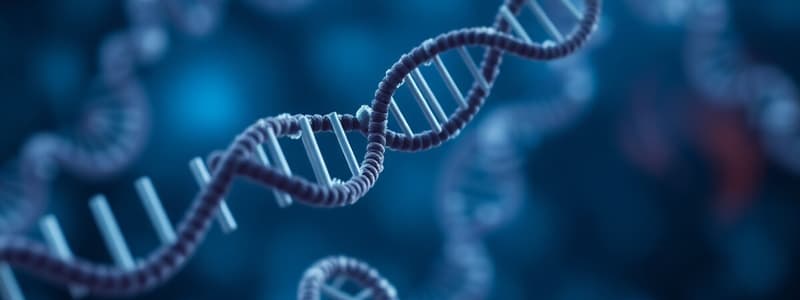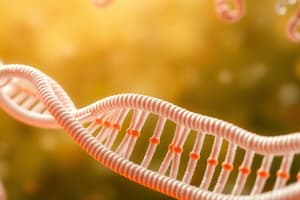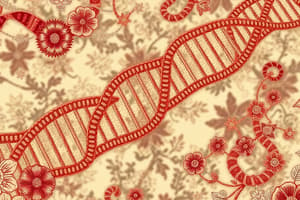Podcast
Questions and Answers
What direction is RNA synthesized during transcription?
What direction is RNA synthesized during transcription?
- 3’ to 5’
- Only in the presence of a primer
- 5’ to 3’ (correct)
- In both directions
Which component is NOT needed for the process of transcription?
Which component is NOT needed for the process of transcription?
- Deoxynucleoside triphosphates (correct)
- Ribonucleoside triphosphates
- DNA template
- RNA polymerase
During RNA synthesis, which base replaces thymidine found in DNA?
During RNA synthesis, which base replaces thymidine found in DNA?
- Adenine
- Cytosine
- Uridine (correct)
- Guanine
Transcription can utilize which strand of DNA as the template?
Transcription can utilize which strand of DNA as the template?
What is the primary difference between RNA and DNA synthesis?
What is the primary difference between RNA and DNA synthesis?
Which of the following statements about RNA polymerases is true?
Which of the following statements about RNA polymerases is true?
Which of the following is an accurate characteristic of the RNA molecule produced during transcription?
Which of the following is an accurate characteristic of the RNA molecule produced during transcription?
How are the initial RNA nucleotides integrated during RNA synthesis?
How are the initial RNA nucleotides integrated during RNA synthesis?
What role does the sigma factor (σ) play in transcription in prokaryotes?
What role does the sigma factor (σ) play in transcription in prokaryotes?
Which subunit of RNA polymerase is directly involved in binding to the ribonucleoside triphosphate (rNTP)?
Which subunit of RNA polymerase is directly involved in binding to the ribonucleoside triphosphate (rNTP)?
What is the significance of the -10 consensus sequence in the promoter region?
What is the significance of the -10 consensus sequence in the promoter region?
During which phase of transcription does RNA polymerase move along the DNA template strand?
During which phase of transcription does RNA polymerase move along the DNA template strand?
What is NOT required for the initiation of RNA synthesis in prokaryotes?
What is NOT required for the initiation of RNA synthesis in prokaryotes?
What happens to the sigma factor after the initiation of transcription?
What happens to the sigma factor after the initiation of transcription?
What physical structure is formed during the elongation process of transcription?
What physical structure is formed during the elongation process of transcription?
Which subunit is primarily responsible for stabilizing the tetrameric core of RNA polymerase?
Which subunit is primarily responsible for stabilizing the tetrameric core of RNA polymerase?
What initiates termination in Rho-dependent transcription?
What initiates termination in Rho-dependent transcription?
What feature is common in Rho-independent termination?
What feature is common in Rho-independent termination?
Which statement accurately describes Rho-dependent termination?
Which statement accurately describes Rho-dependent termination?
Which characteristic is essential for Rho to bind during Rho-dependent termination?
Which characteristic is essential for Rho to bind during Rho-dependent termination?
In the context of transcription, what is the role of the sequence following the inverted repeats in Rho-independent termination?
In the context of transcription, what is the role of the sequence following the inverted repeats in Rho-independent termination?
What is NOT a characteristic feature of Rho-independent terminators?
What is NOT a characteristic feature of Rho-independent terminators?
How does Rho factor facilitate termination in Rho-dependent transcription?
How does Rho factor facilitate termination in Rho-dependent transcription?
What occurs when RNA polymerase reaches the terminator region of a gene?
What occurs when RNA polymerase reaches the terminator region of a gene?
What is a major reason for RNA's lower stability compared to DNA?
What is a major reason for RNA's lower stability compared to DNA?
Why is RNA considered to have multiple functional conformations?
Why is RNA considered to have multiple functional conformations?
Which of the following is NOT a component of DNA replication?
Which of the following is NOT a component of DNA replication?
What crucial role does RNA play in gene expression?
What crucial role does RNA play in gene expression?
In the context of eukaryotic transcription, what is a characteristic feature of RNA?
In the context of eukaryotic transcription, what is a characteristic feature of RNA?
What evolutionary reason supports the use of RNA, despite its instability?
What evolutionary reason supports the use of RNA, despite its instability?
Which of the following statements accurately describes a basic feature of RNA?
Which of the following statements accurately describes a basic feature of RNA?
What is the significance of RNA's temporary nature in cellular processes?
What is the significance of RNA's temporary nature in cellular processes?
Flashcards
RNA structure
RNA structure
RNA has a ribose sugar (with a -OH group) and uracil instead of thymine. It can have complex 3-D structures akin to protein structures.
RNA instability
RNA instability
RNA is less stable than DNA due to the 2' hydroxyl (-OH) group in ribose reacting with the 3' site, potentially causing phosphate bond breakage
RNA's function
RNA's function
RNA's instability allows for temporary function and regulation, potentially shutting off expression.
RNA's adaptability
RNA's adaptability
Signup and view all the flashcards
Central Dogma
Central Dogma
Signup and view all the flashcards
Prokaryotic transcription
Prokaryotic transcription
Signup and view all the flashcards
Eukaryotic transcription
Eukaryotic transcription
Signup and view all the flashcards
Uracil in RNA
Uracil in RNA
Signup and view all the flashcards
RNA synthesis direction
RNA synthesis direction
Signup and view all the flashcards
Transcription template
Transcription template
Signup and view all the flashcards
RNA precursors
RNA precursors
Signup and view all the flashcards
RNA polymerase role
RNA polymerase role
Signup and view all the flashcards
Transcription differences
Transcription differences
Signup and view all the flashcards
RNA synthesis directionality
RNA synthesis directionality
Signup and view all the flashcards
RNA vs DNA bases
RNA vs DNA bases
Signup and view all the flashcards
Multiple genes
Multiple genes
Signup and view all the flashcards
Termination in Transcription
Termination in Transcription
Signup and view all the flashcards
Rho-dependent Termination
Rho-dependent Termination
Signup and view all the flashcards
Rut Site
Rut Site
Signup and view all the flashcards
Rho Factor
Rho Factor
Signup and view all the flashcards
Rho-independent Termination
Rho-independent Termination
Signup and view all the flashcards
Palindrome Sequence
Palindrome Sequence
Signup and view all the flashcards
Poly U Tail
Poly U Tail
Signup and view all the flashcards
Transcription Direction
Transcription Direction
Signup and view all the flashcards
Prokaryotic RNA Polymerase
Prokaryotic RNA Polymerase
Signup and view all the flashcards
Sigma Factor (σ)
Sigma Factor (σ)
Signup and view all the flashcards
Promoter Region
Promoter Region
Signup and view all the flashcards
-10 and -35 Consensus Sequences
-10 and -35 Consensus Sequences
Signup and view all the flashcards
Transcription Initiation
Transcription Initiation
Signup and view all the flashcards
Transcription Elongation
Transcription Elongation
Signup and view all the flashcards
Transcription Bubble
Transcription Bubble
Signup and view all the flashcards
Primer Requirement for Transcription
Primer Requirement for Transcription
Signup and view all the flashcards
Study Notes
Transcription and RNA Processing
- This study guide covers topics from Pierce Chapters 13 & 14.
- RNA is synthesized from DNA templates in all cells.
- Some RNA types are found in both prokaryotes and eukaryotes, others only in eukaryotes, and some only in prokaryotes.
- Gene expression control is a key concept.
- RNA processing is crucial for a variety of processes.
Basic Features of RNA
- RNA uses uracil instead of thymine.
- RNA has a ribose sugar, which has a hydroxyl group on the 2' carbon, giving it more reactivity than deoxyribose.
- RNA has primary, secondary, and tertiary structures, often forming functional units, like in the ribosome.
- RNA structures can resemble proteins in some ways.
The Process of Gene Expression
- Transcription is the synthesis of RNA from a DNA template.
- All cellular RNA is synthesized from DNA templates.
- Some viruses copy RNA directly from RNA.
- RNA synthesis is complementary and antiparallel to the DNA template strand.
- Transcription is in the 5' to 3' direction.
Transcription in Prokaryotes
- Prokaryotes utilize a single RNA polymerase enzyme.
- The holoenzyme includes a core enzyme and a sigma factor.
- The sigma factor binds to specific DNA sequences upstream of the gene for transcription start sites.
- Transcription begins with the DNA unwinding.
- Transcription ends at termination codes.
Two Major Types of Terminators
- Rho-dependent
- Requires a Rho factor which binds to the RNA.
- RNA polymerase pauses, the Rho factor catches up, and unwinds the DNA-RNA hybrid, ending transcription.
- Rho-independent
- Involves an inverted repeat sequence, and a stretch of adenines.
- The sequence creates a hairpin causing the RNA polymerase to pause and then detach from the DNA, ending transcription.
- The inverted repeats will now form a hairpin in the RNA and this causes the RNA to detach from the DNA.
Components needed for transcription:
- DNA Template
- Ribonucleoside triphosphates (rNTPs)
- DNA-dependent RNA polymerase
General Features of RNA synthesis
- Similar to DNA synthesis but uses ribonucleoside triphosphates(rNTPs) instead of deoxynucleoside triphosphates (dNTPs).
- RNA synthesis follows the 5' → 3' direction.
- RNA chains are initiated de novo, needing no primer.
Generalized structure of a prokaryotic gene
- Includes:
- Nontemplate strand
- Promoter -RNA-coding region
- Terminator region
- Transcription start site
Studying That Suits You
Use AI to generate personalized quizzes and flashcards to suit your learning preferences.




